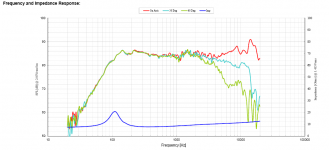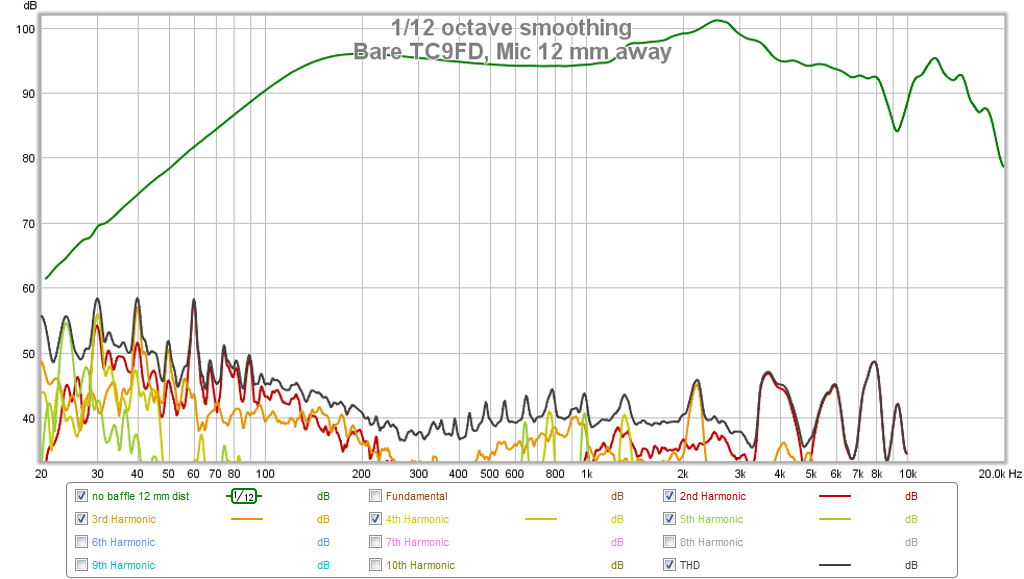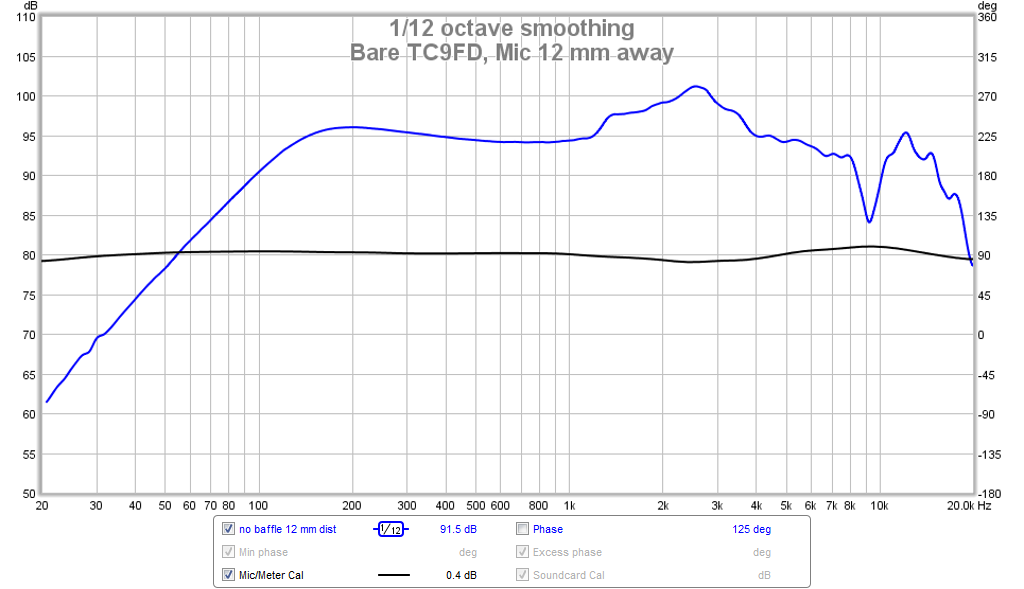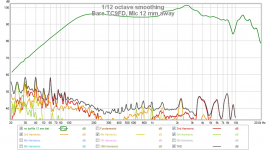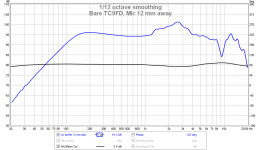Believe what you want. I have 1 PE, and 3 Beringer, all calibrated, none would i bet on above 10k, they are all running on the ragged edge up there. They might give an idea but that is all.
dave
There's nothing to believe. You seem to believe that a calibration file doesn't remove deviations from flat. That is an absurd notion. How would this even be possible? Some mythical creatures changing the capsules over night?
+1
One of my "omni" (and quite good, actually) test mics is close to ruler flat at 90 degrees but rises over 4dB (with obvious peaking to boot) directly on axis.
That's why different calibration files for different angles of incident exist.
A difference of 1/8 inch in where the capsule is placed in the mic body can make a dramatic difference in response over 10kHz. Disassemble/re-assemble the mic even once and if you don't get it back precisely as it was before the calibration curve becomes meaningless, and I've seen examples where a capsule shifted in the body just from "rough handling" (ie. shipping). I have a "standard tweeter" that I keep squirreled away and use for nothing but verifying that mics (both test and recording) are working properly. It does not take much to mess things up when you're dealing with 1/2 inch wavelengths . . .
Those are problems that can occur with any mic regardless how expensive it is.
I thought I already did that . . .Let's keep the discussion on track to being objective. I welcome anyone to present measurements showing that . . . the TC9FD has peaks.
http://www.tymphany.com/files/TC9FD18-08 Spec sheet Rve3_0 100912.pdf
The Madisound Speaker Store
The question is why the manufacturer's data and the vendor's data show the peaks, and your data doesn't. As with all things there's a reason for it somewhere, and we all learn from finding it.
Is the data presented not enough to fulfill your quest for a 3/4" driver with high x-max? Certainly a cheap experiment.
X,
I will take measurements of my A7.3 in some of Dave's cab's and post. It will be in room and at 1 meter, so anything below 1K should be dismissed......I assume.
X,
I will take measurements of my A7.3 in some of Dave's cab's and post. It will be in room and at 1 meter, so anything below 1K should be dismissed......I assume.
I thought I already did that . . .
http://www.tymphany.com/files/TC9FD18-08 Spec sheet Rve3_0 100912.pdf
The Madisound Speaker Store
The question is why the manufacturer's data and the vendor's data show the peaks, and your data doesn't. As with all things there's a reason for it somewhere, and we all learn from finding it.
And I showed that the manufacturer's peaks are about 5 dB, not far off from the peaks I measured at 3 dB, and a falloff of -10 dB at 60 deg. Fairly consistent - I do not dispute the 5 dB peaks for the manufacturer's data.
Again my data from post 226:
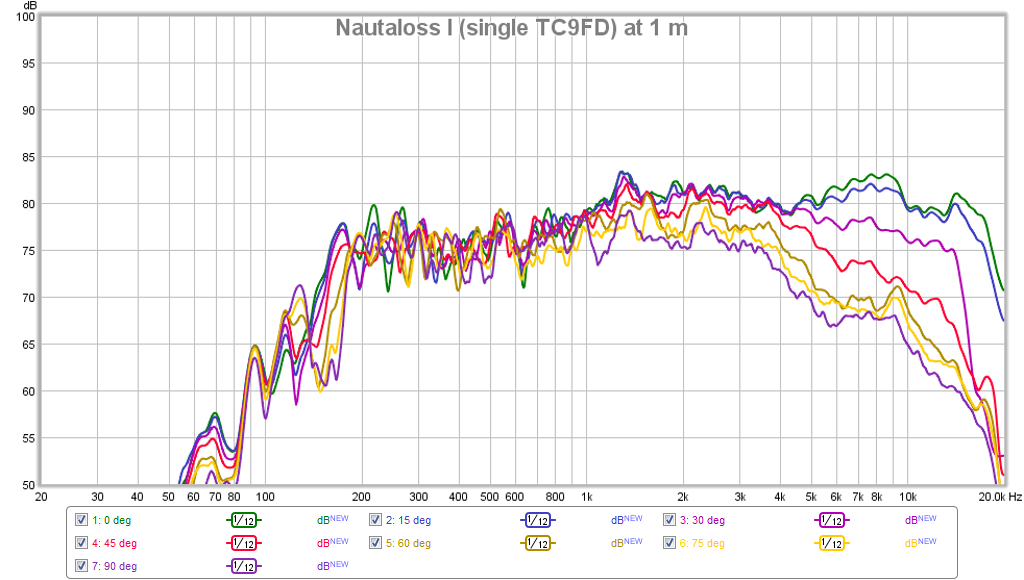
Here is the manufacturer's measurement:
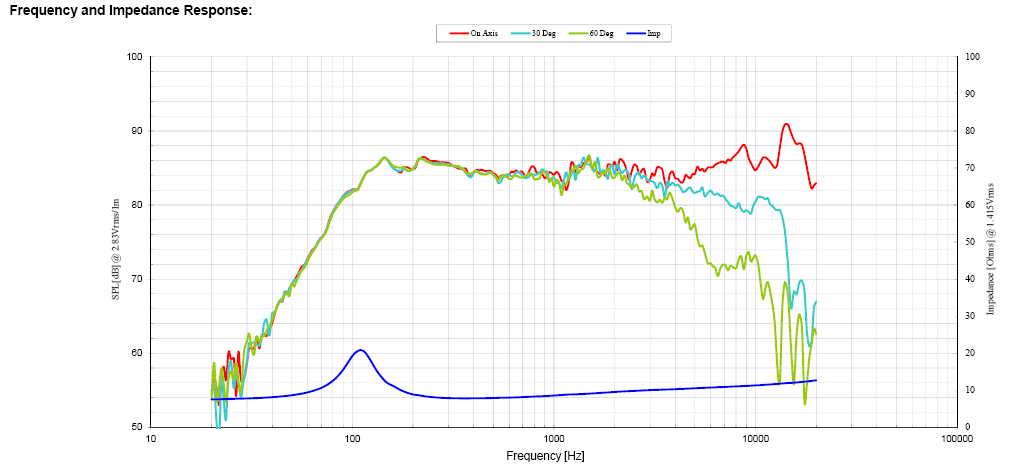
Attachments
I once watched someone doing off-axis measurements of a speaker that was centered (the enclosure was centered) on a rotating table. See what that does to angle of incidence at the mic? See what that does to edge diffraction from the enclosure? None of this stuff turns out to be as simple and "pure" in practice as reductionist theory would have it.That's why different calibration files for different angles of incident exist.
I don't for a moment doubt that the 7.3 has resonant peaking above 10kHz. It shows up in everyone's curves, including the manufacturers. It's probably cone "breakup", but it may be an interaction between the cone and the tweeter "button". It's worse in some measurements than in others, suggesting that there is some variance in cone damping/decoupling from one sample to another, and/or perhaps over time. And despite its presence it does not prevent a lot of people from liking the "sound" of the driver . . . often in preference to others that don't have that "artifact".
Go figure . . .
Why the image is "fantastic" must be because of the Trifield, not because of the driver.
.
Its good in stereo too. I have it setup where I can easily turn off or adjust the volume of the center speaker. I don't always have the center channel on.
I once watched someone doing off-axis measurements of a speaker that was centered (the enclosure was centered) on a rotating table. See what that does to angle of incidence at the mic? See what that does to edge diffraction from the enclosure? None of this stuff turns out to be as simple and "pure" in practice as reductionist theory would have it.
That's why measurements are indispensable.
I don't for a moment doubt that the 7.3 has resonant peaking above 10kHz. It shows up in everyone's curves, including the manufacturers. It's probably cone "breakup", but it may be an interaction between the cone and the tweeter "button". It's worse in some measurements than in others, suggesting that there is some variance in cone damping/decoupling from one sample to another, and/or perhaps over time. And despite its presence it does not prevent a lot of people from liking the "sound" of the driver . . . often in preference to others that don't have that "artifact".
Go figure . . .
I'm not interested in discussing audio mysticism (again). Sound reproduction is an engineering task and I'm only interested in objective data. If you want to discuss likes and dislikes then this thread isn't the right place.
Oh, please . . . your own "mysticism" is that lines-on-paper translate directly to listener perception of sound-in-room. I think that's a better mysticism than some out there, and maybe a little less delusional than many . . . but . . . if you don't care how things sound why do you care about any of this?I'm not interested in discussing audio mysticism (again).
Well, a bit more spicy than the reply I have been fiddling with but the core is there.
Compromises is the answer and how to deal with them - add thruthful measurements from the manufacturers that can be reproduced - and we are home.
Sharing the answers how to deal with the compromises will divide us since it will be worth money. My regards to those sharing!
Compromises is the answer and how to deal with them - add thruthful measurements from the manufacturers that can be reproduced - and we are home.
Sharing the answers how to deal with the compromises will divide us since it will be worth money. My regards to those sharing!
Oh, please . . . your own "mysticism" is that lines-on-paper translate directly to listener perception of sound-in-room. I think that's a better mysticism than some out there, and maybe a little less delusional than many . . . but . . . if you don't care how things sound why do you care about any of this?
we've obviously got it wrong old chap, it's not always just about the music - or perhaps it's synesthesia at play - some folks hear better with their eyes as well as their ears?
The question is why the manufacturer's data and the vendor's data show the peaks, and your data doesn't. As with all things there's a reason for it somewhere, and we all learn from finding it.
The manufacturer and vendor data, in this case, are the one and same thing and I think this perhaps is an important distinction to make here.
Over the course of time Peerless/Tymphany have issued different versions of the datasheets associated with many of their drivers and every time the results are different. Now these differences don't tend to be enough to actually make a large amount of end difference, or make a design for said driver moot, but the point still stands, these differences are present.
Quite clearly something has changed between A and B and this is from the horses mouth itself, so to speak. It is perfectly valid for us to expect differences to appear in our measurements (especially at the frequency extremes) because measurement conditions and drivers are not all identical.
This thread is getting far too serious and specific over minutae that really do not matter. We are not trying to locate a needle in a haystack, we're talking gross driver linearity issues that would completely swamp out any of the small 'bones' that people seem to want to pick.
There are also a lot of replies that seem to be angled towards the defense of a driver when the measurements do not seem to stack up to peoples listening experiences of said driver. Why not just accept that the peaks ARE there and move on. It's already been said that narrow peaks and dips, and especially ones in the top, octave aren't all tha objectionable to the way we perceive the sound to be. They often do not sound unpleasant, but add 'flavour' to the sound that can be perceived as thoroughly enjoyable.
As Markus has pointed out a number of times, sound reproduction is an engineering task and he is quite right with the comments he makes, with regards to linearity being necessary if this is ones absolute goal. Others however are also correct when they've said, what do measurements matter, what matters is ones enjoyment.
If you want to design a system that is perfectly linear, so to speak, then this is ones prerogative. It is not right for people to come in and say, that's a pile of crap, have you actually listened to the thing? Because quite clearly, if it does not measure flat, then it is not true to the original. Sure it may sound nice, but that's not what Markus is trying to get at here.
My system is completely flat to within pretty tight tolerances, however there is a small issue in the off axis at around 15khz, where the off axis bunches up due to the softdome tweeters interaction with the throat of the waveguide it is in. This issue does not appear with the XT25 as the phase plug dramatically reduces the effect. Technically the XT25 gives better performance, but I opt to use the 913000, why? Because that bunching up adds a little sparkle to the sound that I find pleasing. Do I see anything wrong with this? No.
If one is aware of what their system is doing 'wrong' from a technical point of view, then the fact that they enjoy what the system does, does not matter.
If someone wanted me to use my system as a tool, in the same way a good recording engineer does, then I may feel highly compelled to change the tweeter to the XT25. I am not a recording engineer, but on the other hand I do sit strongly in the camp that adheres to excellent objective measurements as being necessary for accurate sound reproduction. I am however, not against dialing in a house curve, or using something that deviates a little from something that is 'objectively better' if I find it more pleasing to listen to.
There's nothing to believe. You seem to believe that a calibration file doesn't remove deviations from flat. That is an absurd notion.
Just good conservative engineering practise. Don'ttrust something at its ragged limit.
dave
We all would that it were that clear, but it's not. Is there anyone here who doesn't already know that a system that measures flat will, in the typical "small" home listening environment, NOT sound "true to the original" but will be perceived as "too bright"? Or that reproduction at a different SPL than the "original" will sound "wrong" at both ends of the spectrum? Or that the recordings themselves are not "flat" because the microphones are uniformly too close to the instruments and capture the sound in a way that you never hear in the hall?Because quite clearly, if it does not measure flat, then it is not true to the original.
It's not an either/or question. We all use "objective" measures to identify areas for improvement and to tweak out "better sound" (whether defined as "perceived to be more true to the original" or simply "more pleasant"). But there is no single objective measure that gets us there (whichever definition you use). There's substantial divergence in the measured performance of the TC9, and general agreement that it sounds good. There's general agreement that the high end of the 7.3 measures bad, and a substantial number of people who say it sounds good.
What's peculiar about the response to the 7.3 is the number of people who don't say it sounds bad, but say it looks bad on paper and therefore it must be bad.
I'm more inclined to think that either we're measuring the wrong things, or assigning the wrong weight and importance to the things that we are measuring, or there's more going on than we yet fully grasp. About all that I'm certain of is that our recordings are flawed, all of them, and our delivery systems are flawed, whether 2 or multi channel, and that our speakers are flawed, and only rarely appropriate to our typically flawed (inappropriate to task) listening environments. So when I hear something that "sounds good" my ears perk up, and I try to figure out why that's happening rather than obsess about all the theoretical reasons why it can't.
- Status
- Not open for further replies.
- Home
- Loudspeakers
- Full Range
- 3"or 4" driver with very good dispersion and high xmax?
